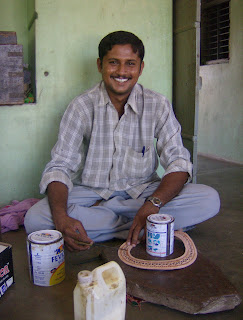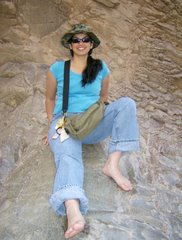 Nirona, Kutch Gujrat
Nirona, Kutch GujratThis is the story of Khet Singh (pictured). He is the youngest of four brothers and has studied through the 10th grade (completed high school). He and his family own farm land outside of Nirona, a larger village (population ~15,000) north of Bhuj, which provides for their livelihood. Currently there are 26 family members living in their house and the best I could break it down is as such:
4 - Khet Singh, his wife and 2 sons
10 - Devjibhai (older brother), his wife and children (6 girls)
2 - Khet Singh's Parents
1 - son of Khet Singh's brother's wife
3 - Khet Singh's eldest brother's children
2 - Goats
1 - Calf
3 - Other kids
26 Total
Supplementing their agricultural income, Khet Singh is a 7th generation leather craftsman. His eldest brother's son is currently training in the art, making it an 8 generation family craft. And this was the purpose of my visit, of course.
Once again we commenced our relations with the best cup of coffee ever. Kutchhi coffee means - strong and just as sweet. It's served very hot in the equivalent of a third of an American coffee cup and is sipped from the saucer. And this was the beginning of my exposure to Kutchhi hospitality.
Before lunch, I was sat down on a mat and brought a pot of

Once again being able to speak in Gujarati was a boon. Their actual language is Kutchhi, which in my opinion has very little resemblance to Gujarati b/c I couldn't understand a lick of it. I was disappointed actually that Khet Singh's mother (pictured) didn't speak Gujarati b/c I would have loved to converse with her. She was so elegant wearing traditional Kutchhi clothes: long cotton skirt, backless cotton top and large silver jewelry. Later on, I asked the family daughters if they would grow up and wear their traditional dress. The answer: most likely not.
I collected costing information on 15 products all in one day. In
But considering the lack of employees, the minimum wage is not the reason Khet Singh is thinking about closing down shop. The biggest problem his is facing the huge jump in the cost of leather. Typically Khet Singh uses camel leather, which is already seasoned and finished, most likely from Rajasthan. Through my research, I was able to show him that on one of his products, he was not even recovering the materials cost, let alone paying his labor cost (or making a profit). The other issue that he is facing is the competition from products made from a cheaper synthetic (plastic) material called Raxin. The quality difference between the synthetic and genuine leather is obvious. Yet, apparently the Indian consumer does not recognize the quality difference and simply demands a cheaper product. So, Khet Singh is also making Raxin products. This made me realize that a large determinant of the sustainability of handmade products is whether the end consumer can differentiate and value and the quality between a handmade and machine made (Batik) and/or synthetic (leather) product. Lastly, another humorous point that KS brought up was that upon realizing that his products are leather, Hindu’s customers quickly drop the product and began reciting God’s name: “Hai Ram, Ram.” KS, a Hindu as well, said, “Don’t they realize that in every temple there is a dhol (drum) that is also made from leather?”
I began to realize the value that I could personally add through my experience with Khet Singh. The material I presented him about his own products gave him an understanding of how to price his products. It was amazing to me that I was able to uncover that he was not recovering even his materials cost on one of his products. Then considering his Rs. 200/day salary, most of his products were being produced at a loss. I’m not saying that KS is a liar, but I have no way to verify that indeed this is the salary he is paying, and so I presented the data assuming a Rs. 50/day wage rate (considered India's rural minimum wage). Even then many of his products were being produced at a loss.
I had a lot of free time on my last day with KS, so I passed the dead zone playing cards with the family children (pictured). We played Gulam Chor, a card game I haven’t played since my childhood in


















